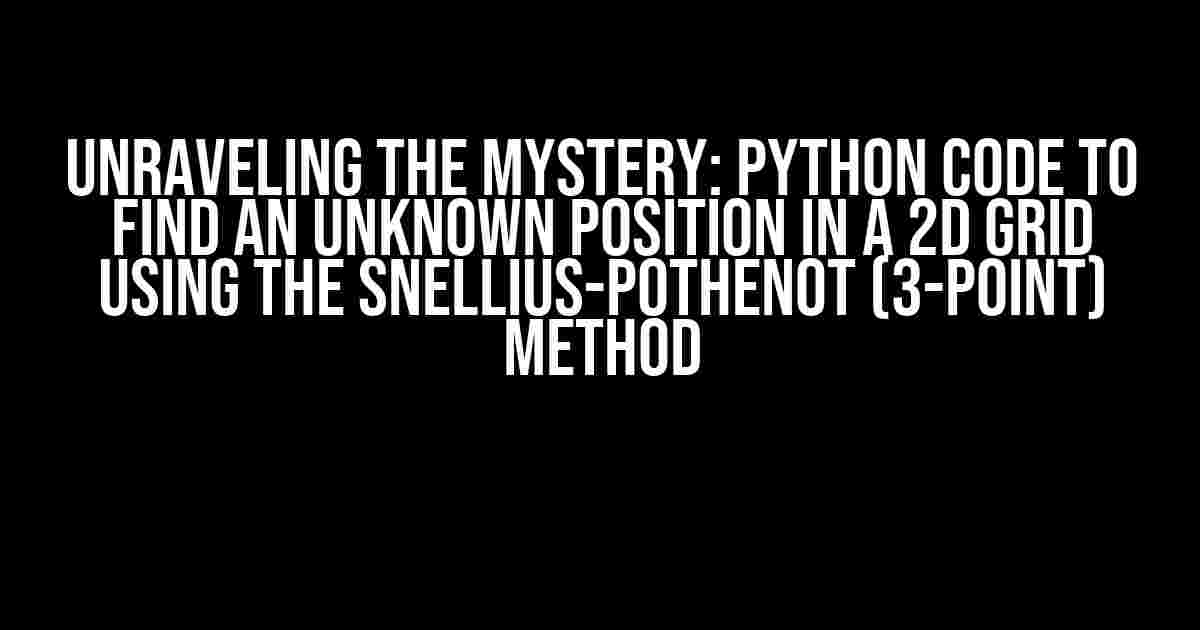Welcome to this exciting journey of exploration! Are you tired of struggling to find an unknown position in a 2D grid? Look no further! In this comprehensive guide, we’ll delve into the fascinating world of triangulation methods and discover how to harness the power of the Snellius-Pothenot (3-point) method to pinpoint an unknown location. By the end of this article, you’ll be equipped with the knowledge and Python code to tackle even the most daunting 2D grid challenges.
What is the Snellius-Pothenot Method?
The Snellius-Pothenot method, also known as the 3-point method, is a trigonometric approach used to determine an unknown position in a 2D grid. This method is particularly useful when you have three known points with their respective distances to the unknown point. The principle is based on the concept of intersecting circles, where the center of each circle represents a known point, and the radius is the distance from that point to the unknown point.
Understanding the Math Behind the Snellius-Pothenot Method
Before we dive into the Python code, let’s take a moment to appreciate the mathematical beauty behind this method. Given three known points (A, B, and C) with their respective distances (dA, dB, and dC) to the unknown point (P), we can create three equations using the Pythagorean theorem:
(x - xA)^2 + (y - yA)^2 = dA^2 (x - xB)^2 + (y - yB)^2 = dB^2 (x - xC)^2 + (y - yC)^2 = dC^2
These equations represent the three circles centered at points A, B, and C, with radii dA, dB, and dC, respectively. To find the unknown point P, we need to find the intersection of these three circles.
Python Code to Implement the Snellius-Pothenot Method
Now that we’ve grasped the mathematical concept, let’s bring it to life with Python! Here’s the code to find an unknown position in a 2D grid using the Snellius-Pothenot method:
import math
import numpy as np
def snellius_pothet_method(point_a, point_b, point_c, distance_a, distance_b, distance_c):
# Unpack coordinates
xA, yA = point_a
xB, yB = point_b
xC, yC = point_c
# Calculate coefficients for the three equations
a1 = 2 * (xA - xB)
b1 = 2 * (yA - yB)
c1 = distance_b**2 - distance_a**2 - xB**2 - yB**2 + xA**2 + yA**2
a2 = 2 * (xA - xC)
b2 = 2 * (yA - yC)
c2 = distance_c**2 - distance_a**2 - xC**2 - yC**2 + xA**2 + yA**2
# Solve the system of linear equations
A = np.array([[a1, b1], [a2, b2]])
B = np.array([[-c1], [-c2]])
X = np.linalg.solve(A, B)
# Calculate the unknown point coordinates
x_unknown = X[0][0]
y_unknown = X[1][0]
return x_unknown, y_unknown
# Example usage
point_a = (0, 0)
point_b = (3, 0)
point_c = (1, 2)
distance_a = 5
distance_b = 5
distance_c = 5.5
x_unknown, y_unknown = snellius_pothet_method(point_a, point_b, point_c, distance_a, distance_b, distance_c)
print("Unknown point coordinates: ({}, {})".format(x_unknown, y_unknown))
How to Use the Python Code
Using the provided Python code is straightforward. Simply call the `snellius_pothet_method` function with the following arguments:
- `point_a`, `point_b`, and `point_c`: The coordinates of the three known points in the 2D grid.
- `distance_a`, `distance_b`, and `distance_c`: The distances from each known point to the unknown point.
The function will return the coordinates of the unknown point.
Tips and Variations
Here are some additional tidbits to keep in mind when working with the Snellius-Pothenot method:
- Ensure that the three known points are not collinear (lie on the same line). If they are, the method will not work.
- In cases where the distances are noisy or have measurement errors, consider using a least-squares approach to find the best fit solution.
- The Snellius-Pothenot method can be extended to higher-dimensional spaces by using more points and equations.
Real-World Applications of the Snellius-Pothenot Method
The Snellius-Pothenot method has numerous applications in various fields, including:
| Field | Application |
|---|---|
| GPS and Navigation | Triangulating a user’s position using satellite signals |
| Robotics and Computer Vision | Localizing a robot or object in a 2D or 3D environment |
| Surveying and Geodesy | Determining the position of a point on the Earth’s surface |
| Wireless Sensor Networks | Locating sensor nodes in a 2D or 3D space |
Conclusion
In this comprehensive guide, we’ve explored the Snellius-Pothenot method, a powerful tool for finding an unknown position in a 2D grid. With the provided Python code and a solid understanding of the underlying math, you’re now equipped to tackle a wide range of applications. Remember to stay curious, keep exploring, and never stop triangulating!
Further Reading
For a deeper dive into triangulation methods and their applications, consider exploring these resources:
- Trilateration: A Guide to 2D and 3D Positioning
- GPS and GNSS: Understanding the Fundamentals
- Computational Geometry: An Introduction
Happy coding and happy triangulating!
Frequently Asked Questions
Get answers to your most pressing questions about finding an unknown position in a 2D grid using the Snellius Pothenot (3-point) method in Python!
What is the Snellius Pothenot method, and how does it help in finding an unknown position in a 2D grid?
The Snellius Pothenot method, also known as the 3-point method, is a technique used to determine the location of a point in a 2D grid using three known points and their corresponding distances to the unknown point. This method is based on the principle of trilateration, where the intersection of three circles (each centered at a known point) gives the coordinates of the unknown point. In Python, we can implement this method using mathematical formulas and a bit of coding magic!
What are the prerequisites to use the Snellius Pothenot method in Python?
To use the Snellius Pothenot method in Python, you’ll need to have a basic understanding of Python programming, as well as some knowledge of mathematics, particularly algebra and geometry. You’ll also need to have the coordinates of three known points and their corresponding distances to the unknown point. Additionally, having a Python IDE (Integrated Development Environment) like PyCharm or VSCode, and a Python version 3.x installed on your system is a must!
How do I implement the Snellius Pothenot method in Python to find the unknown position?
To implement the Snellius Pothenot method in Python, you can use the following steps: define the coordinates of the three known points and their corresponding distances to the unknown point; calculate the intersection of the three circles using mathematical formulas; and finally, use Python’s built-in mathematical functions and libraries (like NumPy and SciPy) to solve the system of equations and find the coordinates of the unknown point. You can also use Python’s visualization libraries like Matplotlib to visualize the 2D grid and the points!
What are some potential limitations or challenges of using the Snellius Pothenot method in Python?
One potential limitation of using the Snellius Pothenot method in Python is that it requires accurate distance measurements and precise coordinates of the known points. Any errors or inaccuracies in these values can lead to inaccurate results. Additionally, the method assumes a flat 2D grid, which may not be suitable for real-world scenarios with complex terrain or obstacles. Furthermore, the method can be computationally intensive for large grids or complex scenarios, requiring optimization techniques to improve performance.
Can I use the Snellius Pothenot method for 3D grids or more complex scenarios?
While the Snellius Pothenot method is typically used for 2D grids, it can be extended to 3D grids or more complex scenarios with some modifications. For 3D grids, you can use four or more known points and their corresponding distances to the unknown point. However, the mathematical formulas and algorithms become more complex, and you may need to use advanced techniques like spatial geometry and trigonometry. For even more complex scenarios, you may need to use more advanced methods like machine learning or computer vision techniques. So, while it’s possible, it’s definitely more challenging and requires a deeper understanding of mathematics and programming!


